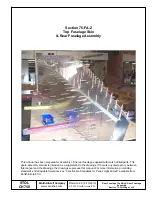
Maintenance Manual V001
FRECCIA
Maintenance Manual V001
FRECCIA
Seite 16
Seite 17
2.7. EMPENNAGES
Classic type and provided with rudder, tail plane, elevator and trim electrically moved.
It is made of composite materials with a shell of sandwich panels composed of carbon glass fibre
and p.v.c. and the spar made of p.v.c.-carbon fibre.
2.8. AILERONS CONTROL
The ailerons control is differential (when the right aileron moves upwards, the left one goes down-
wards and vice versa). The angle of steering on the upwards is wider than the angle of the one
downwards.
The aileron course compared to neutral position is of 24° ±1° upwards and 12° ±1° downwards.
The consequence is the increase of ailerons’ efficiency especially in the big-incidence flight, also
to make up for the different curvature between the back and the underside of the wing.
Replaced through connecting rods and transfers, they efforts on the control handle are passed on
the wing. The controls assembly connects the right control stick with the left one and vice versa.
From each of them a transfer is connected to the respective wing through an extesible-head con-
necting rod. From that a bar inside the wing transmits the movement to the last transfer, integra-
ted into one of two aileron hinges.
Rigging of Ailerons Control
In a neutral position the ailerons’ aft edge must be on the same line as the back part of the wing
tip; the maximum admissible difference upwards or downwars is of 2 mm.
Check if the positions at the end of ailerons running are correct. If it isn’t, follow these steps:
1
Put the aileron upwards;
2
Loosen the push-rod locknuts which are under the wing. Act on the internal nut, by un-
screwing top ut the aileron up or by screwing top ut it down, until its trailing edge has the
indicated distance from the tip’s aft edge (limit switch upwards).
3
Consequently the limit switch downwards is correct thanks to the aileron’s tranfer design.
4
Screw and lock the external checknut.

































